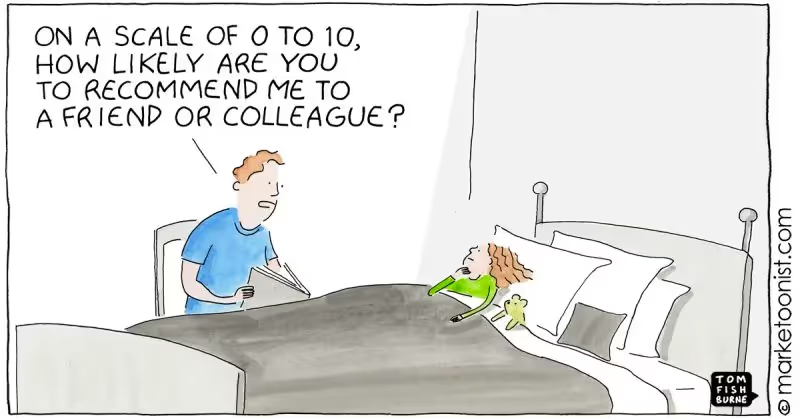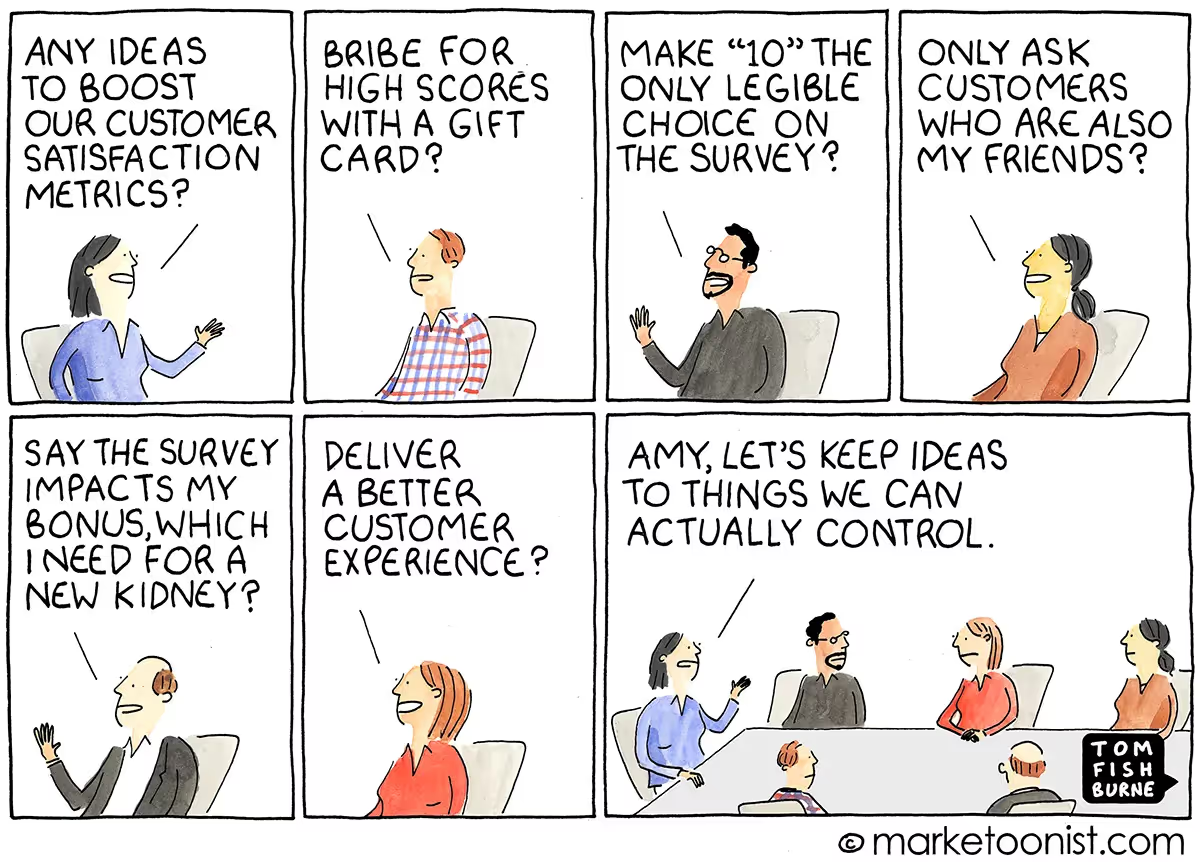 Blog
Blog Evolving NPS From Dial-Up to Fiber Optic: What We Can Learn from Blockbuster, Fax Machines and Paper Maps
Evolving NPS From Dial-Up to Fiber Optic: What We Can Learn from Blockbuster, Fax Machines and Paper MapsEvolving NPS From Dial-Up to Fiber Optic: What We Can Learn from Blockbuster, Fax Machines and Paper Maps

Net Promoter Score (NPS) is a one-question metric that is tracked by two-thirds of the Fortune 1000 and is also celebrating its 20th birthday this year. Former IBM CMO Michelle Pelusa said, ”It’s more than a metric. One could use the word, religion.” (In 2017)

But are we celebrating a metric’s 20th birthday that is limited in its ability to answer this other simple yet important question — ”Why?” Two decades ago, NPS burst onto the scene and became the customer experience metric darling that had businesses swooning. In those 20 years, technology and consumer behavior have dramatically evolved, yet NPS has largely remained the same.
Companies are stuck endlessly asking "how likely are you to recommend," and promoting their NPS performance while failing to ask the other critical questions. As we report NPS trends to our board members and investors, is the score really painting a complete picture of customer value, and are we evolving along with customer needs or are we phoning it in?

It's fascinating to think about other relics from 20 years ago that have come and gone and what those companies could learn from asking the right questions.
The School of Hard Knocks: NPS Lessons from Obsolete Tech
The Fax Machine's Unsent Memo
Would you recommend this fax machine to a friend? Once, it might have been a burning question. But if the fax machine had evolved its question, it would be asking if its speed was faster than email by now. The lesson? Metrics have to grow with technology and customer needs.

One-Hour Photo Labs and the Click-and-Pray Method
Remember the days when you had to wait an hour (or days!) to see if your photos came out the way you wanted? The one-hour photo lab would have had a solid NPS score for 'speed' back in the day. But digital cameras and smartphones happened. Had the one-hour photo lab stuck with asking just one NPS question, they might have missed the boat on understanding why people stopped showing up.
MP3 Players and the Singular Tune
A whole 500 songs in your pocket? Revolutionary! MP3 players would have scored high on the NPS chart for convenience and portability. Yet, here we are, streaming millions of songs from the cloud. Sometimes, being good at one thing is not enough.
Blockbuster’s Be Kind, Rewind Mistake
Ah, the nostalgia of late fees and a physical store where you could touch DVDs. Imagine if Blockbuster had asked, "On a scale of 0-10, how likely are you to recommend our DVD late fee policy to a friend?" it might have told them that customers loved their selection but missed the streaming revolution entirely. A valuable lesson on why we need metrics that not just quantify but also qualify.
Paper Roadmaps and the Lost Art of Navigation
Paper maps might have had fantastic NPS scores for reliability—until GPS and Google Maps drove onto the scene. Navigating customer needs requires updating the map, not just following the old one religiously.
TheySaid’s Customer Journey Pulses & CPV: The Fiber Optic to NPS's Dial-Up
The Technology Leap
Net Promoter Score (NPS) has been the dial-up internet of customer experience metrics—revolutionary when it was introduced but increasingly limited in a world that demands more bandwidth, speed, and nuance. TheySaid CPV, by contrast, is the fiber optic connection that elevates customer understanding to unparalleled levels, thanks to the speed, customization, and actionability it offers.
What is Customer Perceived Value (CPV)?
Customer Perceived Value (CPV) is the subjective assessment a customer makes of the value of a product or service, considering factors like quality, cost, and brand reputation. It influences customer satisfaction, loyalty, and the likelihood of repeat business.
TheySaid's Customer Perceived Value (CPV) engine focuses on the four key aspects of customer experience: Problem, Product, People, and Price. Utilizing the unique Pulse methodology for higher response rates and more meaningful feedback along the customer journey, it employs expert-curated questions to extract valuable insights from decision-makers, enabling businesses to make informed decisions and enhance the value they provide to customers.
What TheySaid’s CPV Learned from NPS
TheySaid's Customer Perceived Value (CPV) Engine innovates on traditional Net Promoter Score (NPS) metrics to provide deeper, more actionable insights for B2B businesses. We'll examine how the CPV Engine incorporates the strengths of NPS while enhancing its limitations, offering a nuanced understanding of customer sentiment across various facets of your business.
What NPS Got Right
Simplicity: One of NPS’s most significant contributions to the field of customer experience metrics is its simplicity. A single, easily digestible number cuts through the clutter, offering a snapshot of customer sentiment.
.avif)
Benchmarking: The universality of NPS allows companies to set their scores against competitors or even against different industries. TheySaid CPV acknowledges the power of comparative insights and builds on it.

The Way You Ask Matters: 5 Ways TheySaid’s CPV Innovates on NPS
Ask the Right Question: While NPS can tell you how many people might recommend your product, it doesn't offer much substance beyond that. TheySaid CPV goes deeper, seeking to understand the 'why' behind customer sentiment across the primary areas of your business:
- Problem
- Product
- Pricing
- People
This makes the insights not only actionable but beneficial for multiple departments—from product development to go-to-market strategy.
1. Asks the Right Person: Unlike NPS, which often casts a broad net, TheySaid’s CPV aims its questions at strategically chosen respondents. By targeting specific customers based on their interactions and stages in the customer journey, it ensures that the right voices are heard.
2. Asks at the Right Time: Timing is everything. TheySaid CPV recognizes this and moves away from the one-off survey model. With its 'Pulses,' CPV provides continuous monitoring, asking simple, yet meaningful questions in the context of where customers are in their journey. This real-time insight makes for an agile and responsive customer strategy.
3. Pulse Over Survey: By adopting a 'Pulse' model, TheySaid CPV enables ongoing conversations with customers rather than just intermittent check-ins. This model results in higher engagement rates and provides a steady stream of actionable insights specifically tailored to B2B needs.
4. Rich, Qualitative Insights: Beyond mere numbers, TheySaid CPV gathers qualitative data that offer context and nuance. These qualitative insights make the metric incredibly actionable, allowing businesses to adapt and improve with a degree of specificity that NPS simply can't offer.
-1.avif)
In much the same way that fiber optic connections didn't erase the need for dial-up but dramatically improved the quality and speed of internet connectivity, TheySaid CPV isn't here to replace NPS. It's here to evolve it. By incorporating continuous, contextual feedback and focusing on actionability, TheySaid CPV addresses the limitations of NPS while building on its strengths.
Ready to experience the fiber optic speed of customer insights? Click here to learn how TheySaid Pulses can take your customer understanding to the next level.





.webp)









.svg)